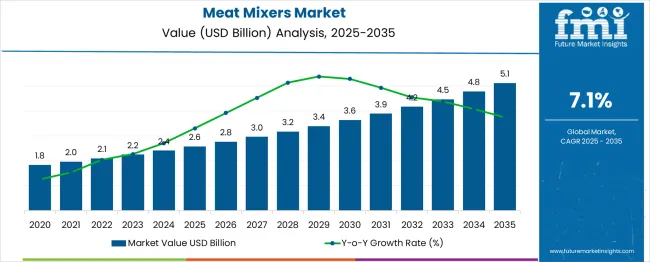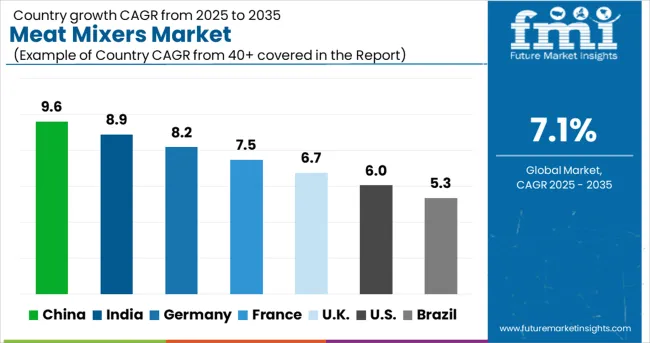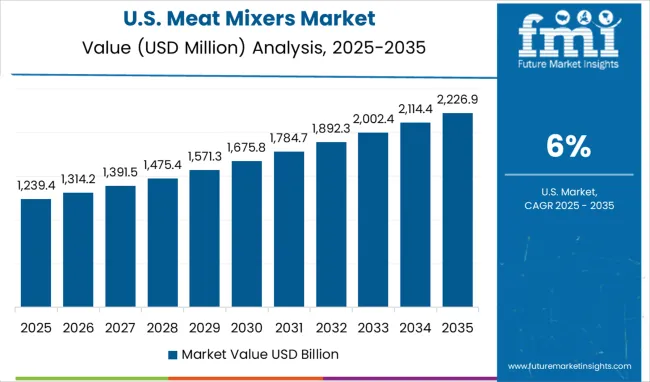The Meat Mixers Market is estimated to be valued at USD 2.6 billion in 2025 and is projected to reach USD 5.1 billion by 2035, registering a compound annual growth rate (CAGR) of 7.1% over the forecast period.

| Metric | Value |
|---|---|
| Meat Mixers Market Estimated Value in (2025 E) | USD 2.6 billion |
| Meat Mixers Market Forecast Value in (2035 F) | USD 5.1 billion |
| Forecast CAGR (2025 to 2035) | 7.1% |
Demand for meat mixers is forecast to increase at a 7.1% CAGR, in comparison to the 6.3% CAGR registered between 2020 to 2024. The number of retail stores has increased dramatically during the previous decade around the world. Factors such as hectic schedules and rising demand for on-the-go snacks and meals will boost sales in the market.
Furthermore, food service providers are increasing their spending on food service equipment such as meat mixers to improve the quality of packaged food products and ready to eat meals. In addition to this, the number of licensed and franchised limited-service restaurants such as McDonald's and Subway is increasing, resulting in high demand for meat processing equipment.


Increasing Demand for Convenience Food in the USA Will Boost Sales of Meat Mixers
Food options that have high nutritional content and fit urban lifestyles are increasingly becoming popular in the USA The "on-the-go" tendency is especially prevalent among millennials, who spend 46% of their food dollars (FMI research) eating out in the USA
Baby boomers, on the other hand, spend 41% of their food budget on eating out. Despite a general slump in the restaurant business, quick-serve restaurants have achieved excellent growth by extending menus and focusing on convenience and price. Menu innovation, store renovations, digital ordering, and delivery are all priorities for leading fast-service restaurants.
Expansion of the Foodservice Sector in China Will Spur Demand for Meat Mixers
In the previous decade, the global processed meat market has risen at an exponential rate, and this trend is anticipated to continue. The market for processed meat is being driven by factors such as rising demand for protein-rich convenience foods and expansion of the foodservice sector in China. This is expected to have a direct impact on sales of meat mixers in China.
Demand for Electric Meat Mixers to Remain High
Based on power type, sales of electric meat mixers will increase at a considerable pace over the forecast period. Any significant industrial kitchen that deals in the preparation of meat packages needs a meat mixer for meat processing. Meat mixers can either be operated manually or electrically.
Sales of Meat Mixers Across Restaurants, Cafes and Food chains to Gain Traction
Interest in different cuisines has been increasing as a result of increased exposure to social media and television shows. Social media has boosted consumers’ interest and love for varied dining experiences. This is altering the face of food tourism, which is gaining popularity globally, particularly among millennials.
Food is now one of the most essential factors for travellers when choosing a destination. Unique cuisine and beverage experiences are becoming more popular among travellers. As a result, the number of food tour companies, food and beverage-themed events, and food and beverage-themed marketing campaigns has expanded worldwide.
Demand for high- and medium-voltage products is being driven by increased renewable energy output and upgrades to existing power infrastructure. Manufacturers and suppliers are working on replacing obsolete foodservice equipment with modern, generally digital, meat mixers to stay competitive.
The long-term expenditures of utilities and maintenance far outweigh the equipment's original purchase price. Purchasing and installing equipment that can costs on annual utility bills is expected to become increasingly popular, fueling demand for contemporary, innovative meat mixers equipment.
| Attribute | Details |
|---|---|
| Estimated Year Value (2025) | USD 2.6 billion |
| Projected Market Valuation (2035) | USD 5.1 billion |
| Value-based CAGR (2025-2035) | 7.1% |
| Forecast Period | 2025 to 2035 |
| Historical Data Available for | 2020 to 2025 |
| Market Analysis | USD Billion for Value and Units for Volume |
| Key Regions Covered | North America; Latin America; Europe; East Asia; South Asia; Oceania; MEA |
| Key Countries Covered | The USA, Canada, Mexico, Germany, The UK, France, Italy, Spain, China, Japan, India, South Korea, Australia, Brazil, Argentina, South Africa, UAE |
| Key Segments Covered | Type, Usage, Style, Capacity, Power Type, End Use |
| Key Companies Profiled | Metos; ABM company; Industries Castellvall; Groupe PSV; Industrial Fuerpla; OMET FOODTECH SRL; Storm Engineering; Schroder Maschinenbau GmbH; MAINCA - Equipamientos Carnicos; Swedlinghaus; Cato; Lakidis; METALBUD NOWICKI; VMI; MINERVA OMEGA GROUP; ASGO; Fatosa; VVS Sausage Machines Factory; Unity Engineering; Dadaux SAS; Ari Makina; LEM Products |
| Report Coverage | Market Forecast, Company Share Analysis, Competitive Landscape, DROT Analysis, Market Dynamics and Challenges, and Strategic Growth Initiatives |
The global meat mixers market is estimated to be valued at USD 2.6 billion in 2025.
The market size for the meat mixers market is projected to reach USD 5.1 billion by 2035.
The meat mixers market is expected to grow at a 7.1% CAGR between 2025 and 2035.
The key product types in meat mixers market are countertop meat mixer and floor meat mixer.
In terms of usage, heavy duty segment to command 58.6% share in the meat mixers market in 2025.






Full Research Suite comprises of:
Market outlook & trends analysis
Interviews & case studies
Strategic recommendations
Vendor profiles & capabilities analysis
5-year forecasts
8 regions and 60+ country-level data splits
Market segment data splits
12 months of continuous data updates
DELIVERED AS:
PDF EXCEL ONLINE
Meat Snacks Market Size and Share Forecast Outlook 2025 to 2035
Meat Alternative Market Forecast and Outlook 2025 to 2035
Meat, Poultry, and Seafood Packaging Market Size and Share Forecast Outlook 2025 to 2035
Meat Extracts Market Size and Share Forecast Outlook 2025 to 2035
Meat Trays Market Analysis - Size and Share Forecast Outlook 2025 to 2035
Meat Interleaving Paper Market Size and Share Forecast Outlook 2025 to 2035
Meat Enzyme Market Analysis - Size and Share Forecast Outlook 2025 to 2035
Meat Stabilizer Market Size and Share Forecast Outlook 2025 to 2035
Meat Processing Equipment Market Size and Share Forecast Outlook 2025 to 2035
Meat Cutting Machine Market Size and Share Forecast Outlook 2025 to 2035
Meat Mincers Market Size and Share Forecast Outlook 2025 to 2035
Meat Tenderizer Market Size and Share Forecast Outlook 2025 to 2035
Meat Starter Cultures Market Size and Share Forecast Outlook 2025 to 2035
Meat Based FPP Market Size and Share Forecast Outlook 2025 to 2035
Meat Dicing Machine Market Size and Share Forecast Outlook 2025 to 2035
Meat Seasonings Market Size and Share Forecast Outlook 2025 to 2035
Meat Substitutes Market Analysis - Size, Share, & Forecast Outlook 2025 to 2035
Meat Packaging Market Trends - Growth & Forecast 2025 to 2035
Meat Emulsions Market Growth - Demand & Industry Insights 2025 to 2035
Analyzing Meat Packaging Market Share & Industry Growth

Thank you!
You will receive an email from our Business Development Manager. Please be sure to check your SPAM/JUNK folder too.
Chat With
MaRIA